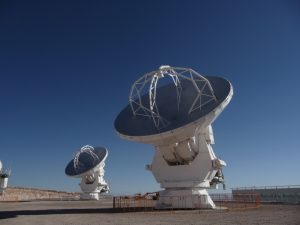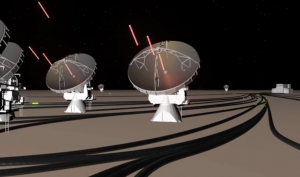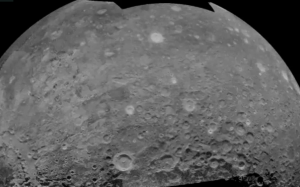Wendy Harper and Erik Gaines, two technicians at the ALMA Front End Integration Facility at NRAO’s Technology Center in Virginia, enjoying a laugh during the filming of a documentary about the building of ALMA.


ALMA Antennas from Japan
Two Japanese, 12-meter ALMA telescopes observing as a combined pair for the first time in the testing area of the ALMA Operations Support Facility in northern Chile.

The ALMA City
The international partners of ALMA built this city in the Atacama desert to support the hundreds of people required to build the world’s most complex astronomical observatory.

ALMA’s Radio Wave Path
In this animation, the radio waves received from objects in space reflect off of ALMA antenna dishes and come to a focus at the subreflector. They bounce down into the center of the dish where the Front End of receiver cartridges sits. Turned into an electronic signal that has been mixed down to a lower frequency that computers can handle, the data travel along fiber optics to the supercomputer known as a correlator. The correlator’s job is to pair up every telescope with every other telesscope and combine their waves. Then those are merged into a single data package from their observation.

Moon Movie in Radar
This movie was created from radar images collected using a transmitter at the Arecibo Observatory (AO) in Puerto Rico and receivers at the Green Bank Telescope (GBT). Radar maps can look like photos, but they represent the amount of energy reflected back toward the transmitter by features on the Moon’s surface. The radar penetrates 10 meters or more into the very dry lunar surface, revealing variations in the abundance of rocks larger than about 10 cm across and seeing differences in the chemistry of rocks that form the Moon’s crust. The movie begins with a view of the north pole of the Moon – the center of the side we can see from Earth is at top. The rotation carries us around the visible edge of the Moon, past the south pole, the giant Orientale basin, and back to the north pole.

Sco X-1, the Movie
This timelapse movie shows 56 hours of changing radio emission from the violent binary system known as Scorpius X-1. Sco X-1 is a star in orbit around a neutron star, the remnant of a supernova explosion. In June of 1999, Sco X-1 brightened and dimmed, and “lobes” of bright radio emission were pushed outward by jets at about half the speed of light. These lobes are made when the fast moving particles in the jet, created from the accretion disk of material in orbit around the dead star, collide with surrounding material caught in the flow. Notice at the start that one moving set of lobes disappears, but new lobes are ejected from the core a few hours later. The size scale is in billions of miles, because Scorpius X-1 covers a volume much larger than our Solar System.





